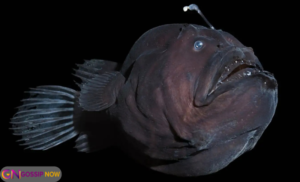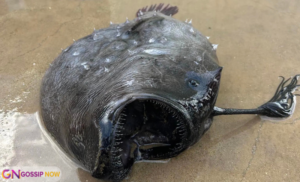The angler fish is one of the most mysterious and terrifying creatures of the deep sea. Found in the darkest depths of the ocean, this fascinating predator has evolved unique survival tactics, including a bioluminescent lure to attract prey. Despite its eerie appearance, the angler fish is a biological marvel, showcasing the power of adaptation in extreme environments.
In this article, we’ll dive deep into the angler_fish’s habitat, size, mating habits, and the rare occasions when they are caught or washed up on shore. Let’s explore the secrets of this deep-sea hunter!
What is an Angler Fish?


The angler_fish belongs to the Lophiiformes order and is found in the midnight zone of the ocean, thousands of feet below the surface. It is well-known for its terrifying appearance, with needle-like teeth, a large mouth, and a glowing lure protruding from its head. This lure, known as the esca, contains bioluminescent bacteria that emit light to attract unsuspecting prey.
Where Do Angler Fish Live?
Angler_fish live in some of the most extreme environments on Earth. They are commonly found:
- At depths of 660 to 3,300 feet (200 to 1,000 meters) in the Atlantic and Antarctic Oceans.
- In areas where sunlight cannot reach, making their bioluminescence crucial for survival.
- Near the ocean floor, where they ambush prey using their glowing lure.
How Big Are They?
The size of an angler_fish varies depending on the species. Some are relatively small, while others can grow surprisingly large.
- Average size: Most angler_fish measure between 8 to 40 inches (20 to 100 cm).
- Largest species: The gigantic angler fish can grow up to 3.3 feet (1 meter) long.
- Male vs. Female size: Male angler_fish are significantly smaller, often only a few inches long.
This extreme size difference plays a crucial role in their unusual mating behavior, which we will discuss later.
Angler Fish Mating: The Bizarre Reproduction Process
One of the most unbelievable facts about angler_fish is their mating process. Unlike most species, male angler_fish do not live independently for long. Instead, they attach themselves to a female and fuse into her body, becoming a permanent parasite.
How Does This Work?
- The male finds a female using his highly developed sense of smell.
- He bites her and latches on, releasing an enzyme that dissolves his mouth and her skin.
- His body merges with hers, connecting their bloodstreams.
- Over time, he loses his eyes, organs, and even his ability to swim.
- The female carries multiple males attached to her, allowing her to reproduce whenever she needs.
This strange mating strategy ensures reproduction in the deep sea, where finding a mate is nearly impossible.
Angler Fish Caught: Rare Encounters with Humans
Angler_fish are rarely caught due to their deep-sea habitat, but on rare occasions, they have been caught by deep-sea fishermen or washed up on shores.
Notable Angler Fish Sightings:
- In 2021, a deep-sea angler fish washed up on a California beach, shocking beachgoers with its eerie, spiky body.
- Fishermen in Japan caught a massive angler_fish in 2018, providing rare footage of this deep-sea predator.
- Occasionally, angler_fish are found in fishing nets, though they typically cannot survive outside their natural deep-sea environment.
Since angler_fish cannot live at shallow depths, most specimens die soon after being caught. This makes live observations extremely rare.
Angler Fish Swimming to Surface: Can They Survive?


Most angler_fish cannot survive at the surface due to extreme pressure changes. The deep sea has immense pressure, and when an angler_fish is brought up to shallower waters:
- Their organs expand, often causing fatal injuries.
- They lose buoyancy control, making it impossible to swim.
- Their bioluminescent lure may stop glowing, as the bacteria require specific deep-sea conditions to survive.
Thus, sightings of angler_fish swimming to the surface are almost unheard of, except in cases where they are dying or have been caught by fishermen.
The Angler Fish’s Unique Hunting Strategy
The angler_fish is a master predator, using camouflage and deception to catch prey.
How Do Angler Fish Hunt?
- They remain motionless on the ocean floor, blending into the dark surroundings.
- Their glowing lure attracts curious fish and squid.
- When prey comes close, the angler_fish lunges forward and swallows it whole with its large mouth.
- They have an elastic stomach, allowing them to consume prey twice their size.
This ambush strategy is necessary because food in the deep sea is scarce.
Conclusion:
The angler_fish thrives in one of Earth’s most extreme environments. Its glowing lure, unique hunting strategy, and bizarre mating habits make it one of the ocean’s most fascinating creatures. Scientists continue to study its deep-sea adaptations, uncovering new details about its survival.
Despite their terrifying looks, angler_fish play an essential role in maintaining deep-sea ecosystems. Every feature of their biology showcases the power of evolution in adapting to extreme conditions.
(FAQs)
1. How big do angler fish get?
Most angler_fish grow between 8 and 40 inches long, but some species reach up to 3.3 feet (1 meter).
2. Can angler fish survive in shallow waters?
No, angler_fish die when exposed to shallow waters because of pressure changes and oxygen differences.
3. What do angler fish eat?
Angler_fish consume small fish, squid, and crustaceans that swim too close to their glowing lure.
4. Do people ever catch angler fish?
Fishermen rarely catch angler_fish, but a few specimens have been found in deep-sea fishing nets.
5. Why do male angler fish look different from females?
Males attach to females, losing their organs and becoming a permanent part of her body for reproduction.






